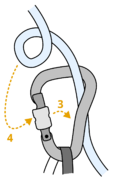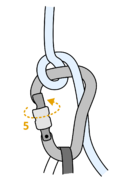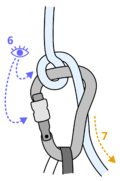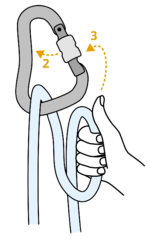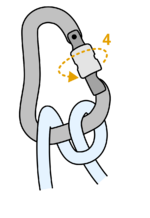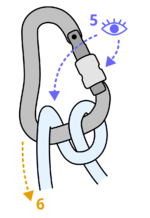Poloviční lodní smyčka
Poloviční lodní smyčka je jedním ze základních uzlů. Je využívána pro jištění bez jistící pomůcky (např. ATC) pouze za pomocí lana a HMS karabiny. Je taktéž využívána v pokročilých lanových technikách (např. při záchranných pracech).
Vázání
Uvázání pro jištění ze štandu (jednoduchá metoda)
Spolehlivá metoda vhodná pro výuku polovičního lodního uzlu.

Udělej očko (1) 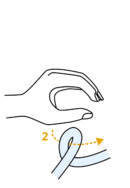
Protáhni palec skrz očko (2) 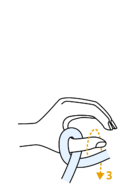
Přehoď lano pře palec a uzavři prsty sevřením palce s ukazovákem (3) 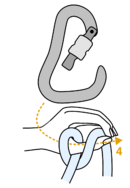
Provleč karabinu lanem přesně podél palce (4) 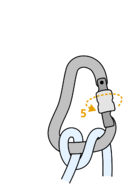
Utáhni zámek karabiny (5) 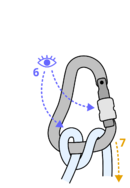
Zkontroluj že vše je správně (6) a nakonec zatáhni za brzdný konec lana (7), půlloďák by se měl přesmyknout na jiný půlloďák
Uvázání pro jištění ze sedáku
Jištění
Vždy drž brzdný konec lana! Jištění s polovičním lodním uzlem je spolehlivé a pohodlné. Když není zatížen, uzel pracuje plynule. Při zatížení poskytuje víc než dostatečné tření pro spolehlivé zachycení pádu. Funguje pod jakýmkoliv úhlem brzdné ruky. Hlavní nevýhodou je že pokud je lano protahováno při zatížení, způsobuje kroucení lana, což je hlavní důvod proč je nyní používán pouze zřídka.
Belaying risks
Belayer should keep their fingers at a respectful distance from the knot. Otherwise they might risk jamming the fingers into the belay, which might result in a severe finger injury.[1] Belayer should also ensure to tie the Munter in a way that it wont interfere with the carabiner gate/lock. Otherwise the rope friction might unlock, and maybe even open the carabiner gate.
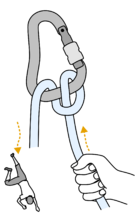
When catching a fall, the rope slips a bit through the Munter. Keep your hand in a respectful distance from the hitch... 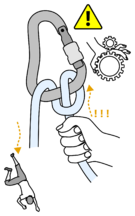
... otherwise you risk jamming a finger 
If you plan to belay from the harness... 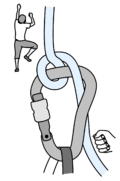
... tie the Munter in a way that it does not interfere with the carabiner gate/lock 
Otherwise the rope friction might unlock... 
... or even open the carabiner during belaying
Tie-off - Mule overhand
To set your hands free from belaying, tie-off the mule overhand. The tie-off consists from a slipknot followed by an overhand knot. Both of them are tied around the sharp end of the rope. The knot looks very tangled as both of these knots are tied with a bight and the rope is also pulled through the carabiner. It takes practice to reliably tie and inspect the tie-off.
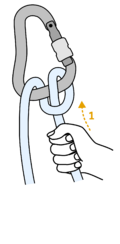
If the knot is not in the correct position, flip the knot by giving a bit of a slack (1) 
Make a loop (2) 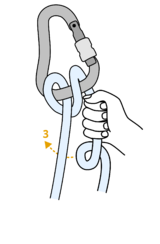
Move it behind the sharp end of the rope (3) 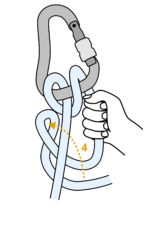
Pull a bight of the rope belay end through the loop (4), making a slipknot around the sharp end 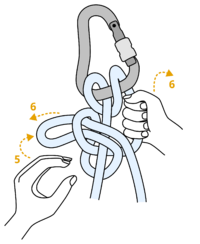
Grab the bight with a hand (5) and simultaneously take slack out of the system while releasing the other hand (6), note that the break strand is still always being held during this step 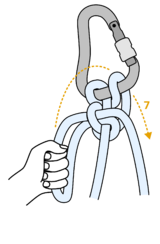
Pull the bight through the carabiner (7), increase its size if necessary for the next steps 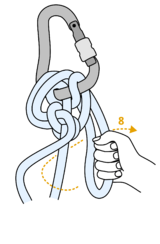
Secure the tie-off... 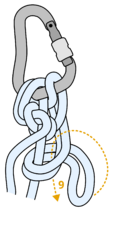
... by making an overhand around the life end of the rope (8,9) 
And the mule-overhand tie-off is done
Alternative tying methods
Metoda jednou rukou
Rychlá metoda pohybem jedné ruky.
Podrobná metoda
Podrobný návod krok za krokem.
File:Munter tie step1.png File:Munter tie step2.png File:Munter tie step3.png File:Munter tie step4.png File:Munter tie step5.png File:Munter tie step6.png File:Munter tie step7.png
References
- ↑ Warning - Gore: "Tying a Munter Hitch Around an Object (updated)". Rescue2Training.com. Rescue 2 Training. Archived from the original on 25 September 2025. Retrieved 25 September 2025.



